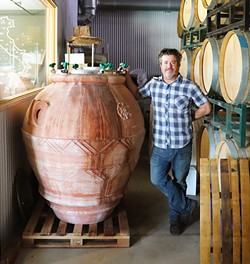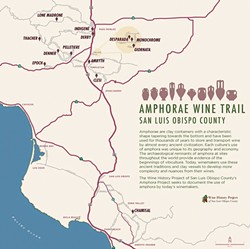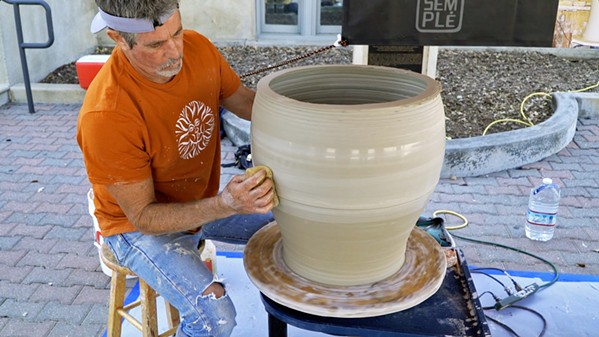Before wine was fermented in wooden barrels or concrete wine tanks, it was made in clay amphorae. The story of this ancient practice begins 6,000 years ago, and it's being revived by a number of local wineries today—work that's celebrated in a new exhibit by the Wine History Project of San Luis Obispo County.

- Photo Courtesy Of The Amphora Project
- ANCIENT METHODS Christopher Ferrara, proprietor and winemaker with Clesi Wines, poses next to an amphora almost as tall as him. Clesi Wines is one of more than a dozen local wineries that are reviving the ancient amphora winemaking method.
"This is about the archeology that tells us about the origins of winemaking, because winemaking started far before we had a written history," said Libbie Agran, Wine History Project director. "It's only really in the 21st century that we have the technology to look at the shards of these clay vessels."
Agran explained that the origin of wine came out of necessity: a way to use crops that otherwise would have perished.
"As we know, we harvest something and then it spoils in two weeks, so how do we keep that food preserved so we can actually eat it all through the winter?" Agran said. "Archeologists began to realize that fermentation is how food was preserved, and certainly how wine was preserved."
For thousands of years, that wine fermentation happened in clay amphorae.
Amphorae are shaped like upside-down eggs, with a narrow neck at the top of the clay container. They've been used since the Neolithic Period to ferment, transport, and store wine, Agran said.
"What we thought was really interesting was looking at the ancient traces of winemaking and then looking at who today in our county is making wines, and why is it that they're looking back at these really ancient traditions?" Agran said.
The resulting Amphora Project exhibit features more than a dozen winemakers in SLO County who use the ancient practice. The Wine History Project interviewed each of them to understand why they're drawn to it and how it changes the wine they make.

- Image Courtesy Of The Amphora Project
- AMPHORA MAP A trip down the SLO County Amphora Wine Trail offers great wine made in an ancient way.
"It sort of dovetails with that natural food, healthy food, organic movements that we've seen," Agran said. "With wine, it is a beverage that things have been added to, whether it's chemicals or sulfites. If you can [make wine] without having to add any chemicals to it, you'd have a natural wine."
The amphora (the singular version of amphorae) also creates a lighter wine with less alcohol, another increasingly popular demand.
"It's healthier," Agran said. "There's less alcohol, so in a sense, you can drink more."
But Agran also believes the draw toward the amphora is rooted in winemakers wanting to create a product that "really expresses the terroir here." Terroir is how a particular region's climate, soil, and terrain impacts its wine.
"They may be using a grape that was developed centuries ago in France, but what does that taste like if you make a natural wine and it's grown in our soil?" Agran said. "This group of [local winemakers] want that terroir to be in that grape, to be in that amphora."
As we walked through the exhibit, located in the Paso Robles History Museum, Agran explained how amphora-aged wine can differ dramatically from wine made in barrels.
"In our county, for years, they used the barrel. We actually used redwood barrels, first. I sometimes wonder, 'What was that taste like?'" Agran said. "Because when you put something in the oak barrel ... it has an element in it of vanilla."
While many wine drinkers enjoy this taste on their palate, Agran said there's a rising interest in wines that aren't impacted by their vessel, "the idea that the wood is imparting some of the flavor to the wine."
"It's very different from an amphora, where you don't get any flavor from the clay at all," Agran said. "What you get in the amphora is something very different: You get a shape."

- Video Screenshot Courtesy Of The Amphora Project
- CLAY CREATION As part of The Amphora Project, the Wine History Project of San Luis Obispo County brought in master potter Scott Semple to do a live demonstration of making an amphora.
The oblong shape allows the grapes—including the skin, which remains with the grapes throughout the process—and gasses to move up and down the amphora naturally. This circulation happens until the sugar converts to alcohol.
"You can put everything in, seal up that amphora, and you don't have to touch it," Agran explained. "You can leave it right where it is and just let it age."
Having the grape skins in the amphora throughout the process also impacts the wine uniquely.
"If you are using your amphora and leaving on the skins, you're going to end up with a wine that is pulling color from the skins," Agran said. "It pulls a lot of flavor from the skins, too."
The Amphora Project includes wineries and vineyards from Edna Valley to Paso Robles, including Chamisal Vineyards, Clesi Wines, Epoch Estate Wines, AmByth Estate Vineyard and Winery, Denner Vineyards, Pelletiere Estate Vineyard and Winery, Giornata Wines, Monochrome Wines, Desparada Wines, Thacher Winery & Vineyard, Derby Wine Estates, Indigené Cellars, and Lone Madrone.
All these winemakers are harnessing the simple power of amphorae to bring their wines back to ancient roots, and the Wine History Project has plans to continue fostering this work.
"We have some really major symposiums that we're going to be doing here," Agran said. "Our objective is to continue to help them make the best quality amphorae wine, and to give them new resources." Δ
Staff Writer Malea Martin wants to go wine tasting on the Amphora Wine Trail. Reach her at [email protected].
Comments
Showing 1-1 of 1